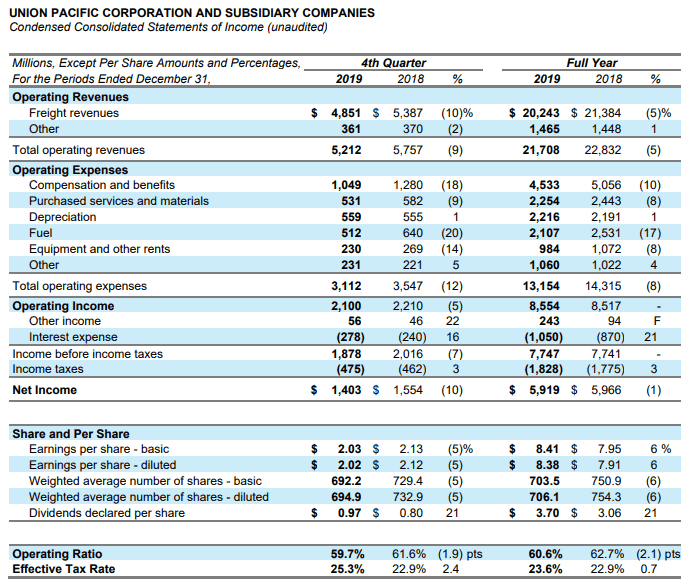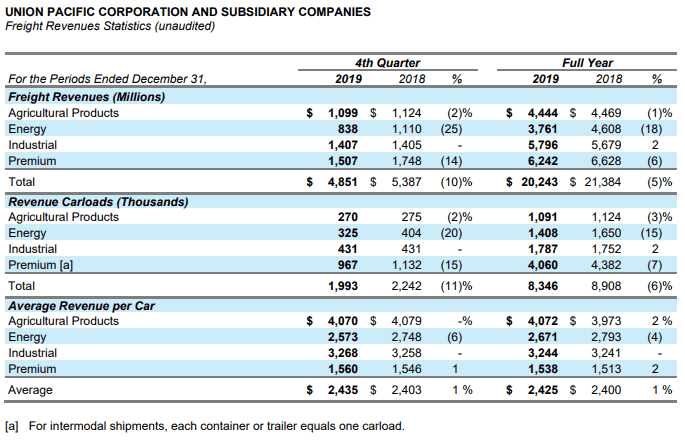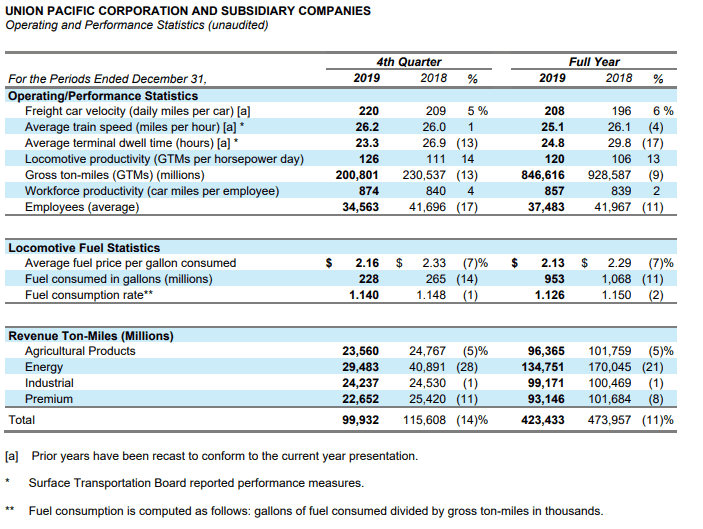Longer trains and headcount reductions are among the initiatives that Union Pacific (NYSE: UNP) expects to deploy to improve its operating ratio in 2020.
Operating ratio (OR), a measure of a company’s financial health, can be calculated by dividing operating expenses by revenue. Union Pacific’s (UP) full-year OR for 2019 was 60.6%, compared with 62.7% for 2018. The company is eyeing an OR of “sub-60” for 2020.
The operating efficiencies that UP has laid out for the year follow expectations for rail volumes to grow by about 1% in 2020 amid gains for its agricultural and intermodal segments and despite anticipated declines for coal and frac sand.
“I don’t think we put a fine point on exactly what volume is going to look like next year,” said UP CEO Lance Fritz during his company’s fourth-quarter 2019 earnings call on Thursday. “But let’s walk you through what needs to happen to have volume growth occur. In intermodal, we need international intermodal to get back to normal, where U.S. consumers feel healthy and they are consuming and it’s coming in off West Coast ports.”
He continued, “For domestic intermodal … We need the truck market to tighten up a bit so the competitive mode isn’t quite as price aggressive and loose as they are right now. We need the trade deals to have a real impact on agricultural exports and imports.”
Manufacturers also need to regain confidence so that they are willing to proceed with capital investments, which could help boost the U.S. industrial economy, Fritz said.
Trade and truck as tailwinds
The removal of some uncertainties in U.S. trade policy, coupled with a slowly tightening truck market, could help support increased rail volumes in 2020.
Areas that could benefit from Phase One of the U.S. trade deal with China include international intermodal and agricultural products, particularly for soybeans but also for corn and wheat volumes around the September time frame, according to Kenny Rocker, UP’s executive vice president for marketing and sales.
“The Phase One trade deal essentially takes China as a headwind and sets it up to be a potential tailwind. [At a] very high level, [China is] committing to over doubling their purchases of U.S. goods, with a concentration in ag[ricultrural products] in some other areas,” Fritz said, pointing out that grain and agricultural exports represent about a third to about 40% of UP’s total agricultural volumes.
Meanwhile, the trade agreement between the U.S., Mexico and Canada (USMCA) also will be a “tailwind” and a “a long-term slow positive impact on our overall volumes,” Fritz said.
Truck capacity in the U.S. also is expected to tighten, which will benefit domestic intermodal, although UP expects truck competition to impact intermodal volumes in the first half of 2020, Rocker said.
“Customers are seeing less dwell [time] for their commodities. We’ve talked about the reduced complexities in Chicago. … All of those things really create a lower cost structure that gives us a lot of confidence that we can compete in the marketplace,” Fritz said.
UP’s plans to increase network efficiency
Executives said UP is planning to achieve about $500 million in productivity initiatives this year. This will come in part from reducing employee headcount by about 8% in 2020, which is under roughly 3,000 employees. UP’s headcount totaled 37,105 in December, according to data submitted to the Surface Transportation Board.
“Our productivity initiatives, coupled with lower volumes, resulted in a 20% decrease in our train and engine workforce, while management, engineering and mechanical workforces together decreased 16%” in the fourth quarter, said Jennifer Hamann, UP’s chief financial officer.
Plans to cut headcount and other productivity initiatives are part of UP’s wider efforts to reorganize assets amid its deployment of Unified Plan 2020, which is UP’s version of precision scheduled railroading (PSR).
In the fourth quarter of 2019 and so far this year, UP has stopped humping railcars at the Davidson Yard in Fort Worth, Texas, reduced switching at the Settegast Yard in the Houston area and shifted the work to the nearby Englewood Yard. UP also curtailed operations at the Armourdale Yard in Kansas City, Kansas, and moved work to the nearby 18th Street Yard, according to Jim Vena, UP’s chief operating officer. UP also previously announced that it stopped humping cars at the Neff Yard.
“We continue to adjust our local operations to align with customer demand while remaining focused on delivering the quality service product,” Vena said. “Going forward, we will continue to look for ways to reduce car touches leading to additional terminal rationalization opportunities on our network.”
Meanwhile, initiatives to improve network efficiency and expand network capacity include increasing train length, acquiring freight cars that will support both replacements and growth opportunities, adding siding extension to increase train length capability in targeted locations and looking at ways to reduce fuel consumption, Vena said.
Train length has grown by 16% from the fourth quarter of 2018 to approximately 8,200 feet in the fourth quarter of 2019.
“In 2019, we invested approximately $3.2 billion in railroad infrastructure. Pending final approval by our Board of Directors for 2020, we are targeting base capital spending of $2.95 billion with an additional $150 million for strategic siding extensions,” Vena said. UP invested approximately $3.2 billion in railroad infrastructure in 2019.
“About 80% of our planned 2020 capital investment is … spending to harden our infrastructure, replace older assets and to improve the safety and resiliency of the network,” Vena said.
Fourth-quarter financials
UP’s fourth-quarter net profit dipped 10% amid a drop in operating revenue.
Net income for the fourth quarter of 2019 totaled $1.44 billion, or $2.02/diluted share, compared with $1.55 billion, or $2.12/diluted share. Operating revenue in the fourth quarter was $5.2 billion, a 9% drop from the same period in 2018.

Fourth-quarter operating revenue slipped amid fewer shipments of agricultural, premium (including intermodal) and energy products, although industrial volumes were flat, UP said Thursday. Freight revenue dipped 10% to $4.89 billion amid lower volumes and a decreased fuel surcharge revenue.
Although revenue was down, operating expenses also fell in the fourth quarter. Operating expenses totaled $3.11 billion, a 12% decline from the fourth quarter of 2018.

The dip in operating expenses contributed to UP reaching an OR of less than 60% in the third consecutive quarter. Fourth-quarter OR was 59.7%, compared with 61.6% in the fourth quarter of 2018.
Service metrics also improved in the fourth quarter, with freight car velocity up 5% to 220 daily miles/car, train speed up 1% to 26.2 miles per hour and terminal dwell down 13% to 23.3 hours. Terminal dwell is the amount of time a train stays at a terminal.
“Continued improvement in asset utilization” and fewer railcar classifications contributed to fourth-quarter improvements in freight car velocity and terminal dwell, Vena said.

| Rail | 2019 Value | 2018 Value | Y/Y Gross Change | Y/Y % Change |
| Freight revenue (in millions) | $4,851.0 | $5,387.0 | ($536.0) | -9.9% |
| Carloads (000s) | 1,993 | 2,242 | -249 | -11.1% |
| Revenue per carload | $2,435 | $2,403 | $32 | 1.3% |
| Gross ton miles (in millions) | 200,801.0 | 230,537.0 | -29,736 | -12.9% |
| Revenue per ton mile (in millions) | $99,932 | $115,608 | -$15,676 | -13.6% |
| Employee counts | 34563 | 41696 | -7,133 | -17.1% |
| Train velocity (mph) | 26.2 | 26 | 0 | 0.8% |
| Dwell time (hours) | 23.3 | 26.9 | -4 | -13.4% |
| OR% | 59.7% | 61.6% | -1.9% | -3.1% |
| EPS | $2.02 | $2.12 | -$0.10 | -4.7% |







